Abstract
In the last decade the reduction of carbon dioxide emissions in the transport sector, including the marine sector, has become the direction of its strategic development. Increased air pollution in the air is one of the main reasons for premature deaths around the globe. It was determined that while many methods provide adequate information about pollution levels, improvements could be made to avoid major errors. The traditional methods are either expensive or require a lot of data and human resources to correctly evaluate those data arrays. To avoid these problems, artificial neural networks (ANN) and other machine learning methods are widely used nowadays. Many ANN models for ship pollution evaluation in ports either included the whole port area or went even further and included cities near port areas. These studies show that ANNs can be effectively used to evaluate air pollution in a wide area. However, there is a lack of research on ANN usage for individual ship pollution or ship plume evaluation. This study attempts to fill this gap by developing an ANN model to evaluate an individual ship’s plumes by combining several data sources such as AIS data, meteorological data, and measured the ship’s plume pollutants concentration. Results show good correlation; however, additional limitations have to be overcome regarding data filtering and the overall accuracy of the model.
1. Introduction
In the last decade, reduction of carbon dioxide emissions in the transport sector, including the marine sector, has become the direction of its strategic development. In September 2020 the European Union (EU) Commission adopted ambitious plans to reduce greenhouse gas emissions by at least 55% by the end of 2030 and to achieve climate neutrality by the end of 2050 [1]. To achieve these results for the international maritime transport sector by 2050, the plan is to reduce CO2 emissions by at least 82% compared to 1990 [2]. However, the fact that shipping (with small exceptions) is currently exclusively using fossil fuel complicates the solution to the problem in the maritime transport sector [3]. Thus, 97% of the 44 million tons consumed by the ships registered in 2018 were made by liquid fossil fuel. Accordingly, in 2018, the fuel of 98.4% of all ship engines was conventional marine fuel. It means that, until a significant percentage of the fuels is replaced by renewable and low-carbon fuels, the main benefit is to consider increasing the efficiency of energy use in marine vessels. Given this information, the latest international maritime organization (IMO) initiatives to limit CO2 emissions as well as the most toxic components in exhaust gas from ship power plants (SPP) include all technological methods of ships operations, both for voyages and operations in the port [4]. The IMO pays a lot of attention in particular to the decarbonization of marine transport and the eco-friendliness of the port. According to statistics [5], pollutants emitted at the quays account for about 6% of the total CO2. At the same time, sulfur oxides (SOx), nitrogen oxides (NOx), and particulate matter (PM) have a major impact on air pollution in coastal agglomerations and port cities. In certain regions of Europe, the amount of these pollutants can reach up to 80% of NOx and SOx, and up to 25% of PM2.5 [6]. As a result, the discharge of greenhouse gases and toxic components from the ship power plants is one of the main causes of negative effects on human health, which exceeds the permissible norms in the port territories.
In recent years. increasing air pollution is becoming an even more serious problem that affects many areas, from cities to ports. Global shipping traffic in recent years, more specifically in 2019–2020, took a serious reduction due to the COVID-19 pandemic [7,8,9,10], however recent statistics show a rapid traffic increase. According to European maritime safety agency (EMSA) data, the shipping traffic from 2019 to 2022 increased by 8% while in the years from 2019 to 2020, and from 2019 to 2021, traffic trends were negative: −15% and −1%, respectively [9]. Increasing maritime traffic contributes to growing pollution in ports and port cities [11,12]. Increased air pollution and especially particulate matter (PM) concentration in the air is one of the main reasons for premature deaths around the globe. Even without premature deaths, increased particulate matter can cause various diseases, such as cerebrovascular diseases, pulmonary diseases, hospital admissions, cardiovascular diseases, and others [13,14,15,16,17]. The most complex evaluation and control are nitrogen oxides and particulate matter in the ship plume during ships operations in the port, as it depends on practically uncontrollable factors, such as: the real SPP load level, organization of SPP fuel combustion cycle, SPP technical condition, etc. Contrary to the evaluation and control of the emissions of the ship standing by the quay, the direct measuring of emissions in SPP exhaust gas in an organized manner is not possible. Many theoretical and practical studies have been dedicated to the solution to this problem, especially in recent periods.
Considering the danger presented by increased particulate matter in the air, it is required to measure, monitor, and take action to prevent excessive amounts of PM in the air [18]. There are a lot of methodologies concerning how to measure and predict pollution from ships. Many of those methods were reviewed in a previous publication [19]. It was determined that while many methods provide adequate information about pollution levels, improvements could be made to avoid major errors. The traditional methods are either expensive, because of the need for external devices such as unmanned aerial vehicles or stationary measuring devices [20,21,22] or require a lot of data and human resources to correctly evaluate those data arrays [23,24,25]. Another issue with traditional methods is that the calculations of emissions based on ship statistics are characterized by major errors [26].
To avoid these problems, artificial neural networks (ANN) and other machine learning methods are widely used nowadays. In most cases, ANNs are used for air quality determination in cities and many cases evaluate stationary pollution sources or wide areas [27,28,29,30,31,32]. ANN usage also helps with data array correlations between each other and reduces the work required by a human.
There are a lot of ANN models, such as convolutional neural networks (CNN), backpropagation neural networks (BPNN), recurrent neural networks (RNN), gated recurrent units (GRU), long short-term memory neural networks (LSTM), and bidirectional long short-term memory neural networks (Bi LSTM) [33,34,35,36,37]. Each has its advantages and disadvantages. Prediction accuracy depends on the structure of the neural network [37,38].
Other studies which tried to use ANNs for ship pollution evaluation in ports either included the whole port area or went even further and included cities near port areas [28,39]. These studies show that ANNs can be effectively used to evaluate air pollution in wide areas. However, there is a lack of research on ANN usage for individual ship pollution or ship plume evaluation. This study attempts to fill this gap by developing an ANN model to accurately evaluate the plumes of individual ships.
2. Materials and Methods
Research is based on using ship AIS positions and exhaust gas plume analysis. Due to the geographical positioning of the port of Klaipeda, ships move along a narrow channel in the Curonian lagoon, along Klaipeda city. During the western winds, the exhaust gas plume is blown to the port and the city and can be registered by the air pollution analysis equipment positioned in the port. During the movement of the ship, the exhaust gas plume moves in parallel to the ship; when the plume moves through the measurement station, the data on the concentrations of the horizontal slice of the plume is registered (Figure 1).
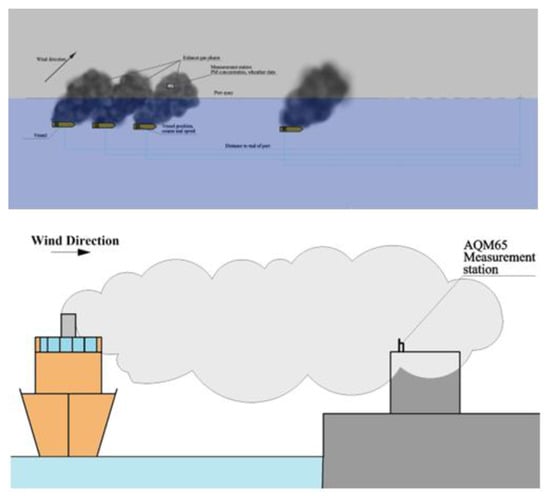
Figure 1.
Schematic representation of exhaust gas plume measurement.
The position of every ship (coordinates and position relative to the end of port), speed above ground as well as weather parameters are registered at time tx with time intervals of 1.5 min. Ship technical data is added from the ship register database based on the IMO number. Exhaust gas plume measurements were made with AQM 65 measurement station [40]. Pollutants’ measurement (PM1, PM2.5, PM10) was conducted 24/7 with a measuring time interval of 1 min for 46 days. Time intervals of the position of every ship (coordinates and position relative to the end of port), speed above ground, as well as weather parameters and pollutant measurements were synchronized according to AIS data, using linear interpolation, for final data array.
2.1. Ship Technical-Specification Data
Ship technical data (Table 1) was taken from the IHS Fairplay world shipping encyclopedia. The matching of technical data to ships was based on the IMO number in the AIS system and IHS Fairplay database.

Table 1.
Ship technical data collection.
2.2. Weather Data
Weather data (Table 2) was carried from two sources: measured directly using the sensors on the station and from available archives online. Weather data was available at a frequency of 30 min [41]. Linear interpolation was used to determine the weather data conditions for each minute of AIS data.

Table 2.
Weather data collection.
2.3. AIS Data
AIS data was provided by the Lithuanian transport safety administration. AIS data was filtered based on coordinates, limiting the data to only ships that were operating in Klaipeda port waters. Parameters for identification of the ship as well as the definition of position, movement speed, and direction at time t were used (Table 3).

Table 3.
AIS data collection.
2.4. Neural Network
For neural network training, a neural designer data science and machine learning platform (version 5.9.8) [42] was used. An approximation network was used consisting of 17 inputs (Table 1, Table 2, Table 3 and Table 4) and 3 target variables consisting of PM1; PM2.5; PM10 concentration (µg/m3) measured using AQM 65 station. In total 81,949 lines of data array were made (Figure 2). Wind direction was selected such that wind would carry the ship plume to the AQM65 station side. We excluded wind direction from the east side. The numerical form of wind direction used in the data array was in degrees and between 180 and 360.

Table 4.
Parameters of neural network.
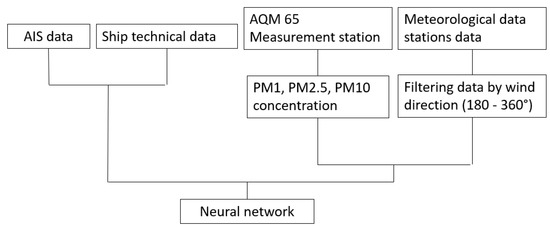
Figure 2.
Algorithm for neural network preparation.
A standard distribution of 60% training samples, 20% selection samples, and 20% testing samples was made for the training of the network. A neural network of 5 layers with 4 Hyperbolic tangent (tahn) activation functions was chosen (Table 4). Normalized squared error (MSE) was selected for the loss index. The regularization term measures the values of the parameters in the neural network. For the regularization, L2 method, consisting of the squared sum of all the parameters in the neural network, was selected. The adaptive moment estimation method (Adam) was used for training.
3. Results and Discussions
Modeling results showed a good correlation with measurement data for the whole data array R2 = 0.903 for PM1, R2 = 0.880 for PM2.5, and R2 = 0.807 for PM10, respectively. The mean squared error for testing samples was 0.123.
A comparison of individual ship plume measurements is presented in Figure 3 in relative values (CM/CANN). Each measurement point was registered when the measurement station was downwind from the maneuvering vessel. Four different ship types are presented:
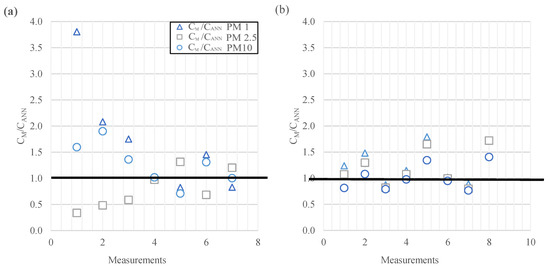

Figure 3.
Comparison of measured and calculated concentrations: (a) bulk cargo ship, (b) chemical tanker, (c) trawler, (d) refrigerated cargo ship.
a—a bulk cargo ship with a deadweight of 56,810 t and main engine power 9480 kW(measurement distance 0.44–3.92 km);
b—a chemical tanker with a deadweight 650 t and main engine power of 625 kW (measurement distance 1.07–3.29 km);
c—a trawler with a deadweight of 30 t and engine power of 221 kW (Measurement distance 0.51–3.8 km);
d—and a refrigerated cargo ship with a deadweight of 2713 t (0.32–3.95 km) and main engine power 2601 kW(measurement distance 0.32–3.95 km).
For wider analysis, results by ship type are presented in Figure 4 for four ship types. The coefficient of determination for each type of vessel is in the range R2 = 0.66–0.80 for RoRo, R2 = 0.91–0.94 for general cargo, R2 = 0.71–0.92 for bulk, and R2 = 0.75–0.91 for tugs. The worst correlation and sum squared error are for RoRo vessels. These vessels are among the tallest vessels that enter port, which in some cases can result in their exhaust gas plume moving above the measurement station. Furthermore, it should be noted that part of the RoRo vessel fleet is equipped with scrubbers that are known to reduce PM emissions by a significant percentage. Since data about scrubbers is not included in the IHS Fairplay database used for this analysis, this could cause significant errors in the prediction of PM concentration in the RoRo exhaust gas plume. The best correlation was determined for the general cargo ships (b). The big errors, especially well seen in case d, are associated with an incorrect selection of time for emission peak concentration, predicting exhaust gas plume earlier/later than it occurs, and less with an incorrect prediction of concentration levels.
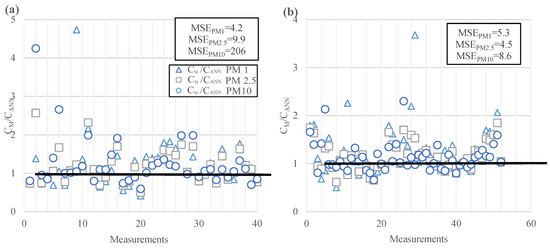
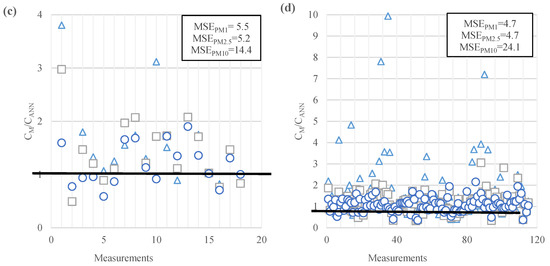
Figure 4.
Comparison of measured and calculated concentrations: (a) RoRo ships, (b) general cargo ships, (c) bulk carriers, (d) tugs.
The deployment of the model allows for the evaluation of different conditions and impacts of ship exhaust gas plume. Model deployment was performed by supplying the ANN with data from an average tugboat with an engine power of 2500 kW and at a distance of 135 m, moving at speeds of 10.7 knots (20 km/h). Different wind speed was modeled for the same location. It was determined that the biggest concentration reaches the shore when wind speed is in the range of 9–12 m/s for all particulate matter sizes. At wind speeds of 3 m/s and less, the concentration becomes indistinguishable from the background. The structure of the plume was presented in Figure 5. The full exhaust gas plume concentration range was obtained by changing the wind direction from a single vessel source at the same distance during a wind speed of 9 m/s. The peak concentration reaches 27 µg/m3 for PM10, 21.6 µg/m3 for PM2.5, and 20 for PM1.
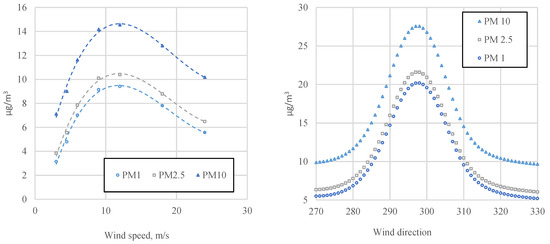
Figure 5.
Comparison of modeled exhaust gas plume structure.
The data on shipping power consumption and emissions have always been limited and diverse [43]. Different propulsion plants, level of technological maintenance, age of the ship, and quality of fuel used by the ship are all influencing factors [44]. This is especially case in ports where it is difficult to predict pollutant emissions due to the complexity associated with low engine load, transient effects, and multiple external influencing factors [45,46,47]. Due to these difficulties, in many port emission evaluation models shipping can be omitted as an emissions source [48]. The lack of comprehensive tools makes it difficult for port operators to evaluate the level of impact that is occurring due to shipping activities at the current time. Online measurement stations are one of the more available solutions, however, a significant number of them are necessary to sufficiently cover port territory, and purchase and maintenance prices can become prohibitive.
Due to the aforementioned limitations, it is difficult to evaluate the impact shipping activities can have in ports, and due to the relatively slow change in the world fleet, this is going to remain a complicated issue for some time. It is there for necessary task to develop robust tools for shipping impact evaluation that could be used in port areas for evaluation and real-time prediction of pollutant impact. This is where machine learning can be accepted as one of the possible solutions [43,49]. Presented research results show a promising potential for artificial neural network use in these cases. Even though currently there are cases where ANN makes major inaccuracies, especially when the concentration level is low or exhaust gas abatement technologies are used on board, as was seen with RoRo vessels, with improvements in data filtering and expansion in training data array size, prediction accuracy is expected to increase substantially.
ANN also allows us to perform an analysis of exhaust gas plume dispersion in different environmental conditions, ship positions, distances, etc. Performing this only with experimental measurements would be very complicated in the technologically dynamic environment of a seaport.
However, an increase in alternative fuel use in the future can further complicate model use. Therefore, the periodical addition of data and retraining are necessary. With more data gathered from in-port measurements, the model accuracy can be significantly improved.
4. Conclusions
Due to the growing attention towards air pollution in port by vessels, effective monitoring and modelling techniques have to be developed. This study shows that ANN models can be used for the prediction of exhaust gas plume concentration during different weather conditions, circumventing direct emission measurement and only using the technical characteristics of the vessel, weather conditions, and AIS data.
Developed ANN models can be used to model the exhaust gas plume for different vessels, analyze the exhaust gas plume structure, and estimate the impact for effected territories such as port terminals or close urban territories.
Limitation to model accuracy exists because of a lack of data on emission abatement technologies and quality/type of fuel used on board the vessel. Additional data and the periodical retraining of the model are necessary for full model implementation.
Author Contributions
Conceptualization, P.R., G.Š. and S.L.; methodology, P.R.; software, P.R.; validation, P.R. and G.Š.; formal analysis, G.Š. and S.L.; investigation, P.R., G.Š. and S.L.; resources, P.R. and G.Š.; data curation, S.L. and P.R.; writing—original draft preparation, G.Š. and P.R.; writing—review and editing, G.Š., P.R.; visualization, P.R., G.Š.; supervision, S.L. and P.R. All authors have read and agreed to the published version of the manuscript.
Funding
This research received no external funding.
Institutional Review Board Statement
Not applicable.
Informed Consent Statement
Not applicable.
Data Availability Statement
Not applicable.
Conflicts of Interest
The authors declare no conflict of interest.
Nomenclature
| AIS | automatic identification system |
| ANN | artificial neural network |
| CANN | concentration calculated by the trained ANN |
| CM | measured pollutant concentration |
| CO2 | carbon dioxide |
| DWT | deadweight tonnage |
| EU | European union |
| GT | gross tonnage |
| IMO | international maritime organization |
| NOx | nitrogen oxides |
| PM | particulate matter |
| SOx | sulfur oxides |
| TSP | total suspended particles |
References
- European Commission. Amended Proposal for a Regulation of the European Parliament and of the Council on Establishing the Framework for Achieving Climate Neutrality and Amending Regulation (EU) 2018/1999 (European Climate Law); COM(2020) 563 Final; European Commission: Brussels, Belgium, 2020. [Google Scholar]
- European Commission. Communication from the Commission to the European Parliament, the Council, the European Economic and Social Committee and the Committee of the Regions Stepping Up Europe’s 2030 Climate Ambition Investing in a Climate-Neutral Future for the Benefit of Our People; COM(2020) 562 Final; European Commission: Brussels, Belgium, 2020. [Google Scholar]
- European Commission. Commission Staff Working Document Full-Length Report Accompanying the Document Report from the Commission 2019 Annual Report on CO2 Emissions from Maritime Transport; SWD(2020) 82 Final; European Commission: Brussels, Belgium, 2020. [Google Scholar]
- European Commission. Proposal for a Regulation of the European Parliament and of the Council on the Use of Renewable and Low-Carbon Fuels in Maritime Transport and Amending Directive 2009/16/EC; COM(2021) 562 Final; European Commission: Brussels, Belgium, 2021. [Google Scholar]
- European Environment Agency. Aviation and Shipping: Impacts on Europe’s Environment: TERM 2017: Transport and Environment Reporting Mechanism (TERM) Report; Publications Office: Luxembourg, 2018.
- European Environment Agency. The Impact of International Shipping on European Air Quality and Climate Forcing; Publications Office: Luxembourg, 2013.
- United Nations Conference on Trade and Development. Review of Maritime Transport 2021; United Nations: Geneva, Switzerland, 2021; ISBN 978-92-1-113026-3. [Google Scholar]
- Gavalas, D.; Syriopoulos, T.; Tsatsaronis, M. COVID–19 impact on the shipping industry: An event study approach. Transp. Policy 2021, 116, 157–164. [Google Scholar] [CrossRef] [PubMed]
- European Maritime Safety Agency. COVID-19—Impact on Shipping; EMSA: Lisbon, Portugal, 2022; p. 23.
- Millefiori, L.M.; Braca, P.; Zissis, D.; Spiliopoulos, G.; Marano, S.; Willett, P.K.; Carniel, S. COVID-19 impact on global maritime mobility. Sci. Rep. 2021, 11, 18039. [Google Scholar] [CrossRef] [PubMed]
- Mamoudou, I.; Zhang, F.; Chen, Q.; Wang, P.; Chen, Y. Characteristics of PM2.5 from ship emissions and their impacts on the ambient air: A case study in Yangshan Harbor, Shanghai. Sci. Total Environ. 2018, 640–641, 207–216. [Google Scholar] [CrossRef] [PubMed]
- Kim, Y.; Moon, N.; Chung, Y.; Seo, J. Impact of IMO Sulfur Regulations on Air Quality in Busan, Republic of Korea. Atmosphere 2022, 13, 1631. [Google Scholar] [CrossRef]
- Mao, J.; Zhang, Y.; Yu, F.; Chen, J.; Sun, J.; Wang, S.; Zou, Z.; Zhou, J.; Yu, Q.; Ma, W.; et al. Simulating the impacts of ship emissions on coastal air quality: Importance of a high-resolution emission inventory relative to cruise- and land-based observations. Sci. Total Environ. 2020, 728, 138454. [Google Scholar] [CrossRef]
- Toscano, D.; Murena, F. Atmospheric ship emissions in ports: A review. Correlation with data of ship traffic. Atmospheric Environ. X 2019, 4, 100050. [Google Scholar] [CrossRef]
- Toscano, D.; Murena, F.; Quaranta, F.; Mocerino, L. Assessment of the impact of ship emissions on air quality based on a complete annual emission inventory using AIS data for the port of Naples. Ocean Eng. 2021, 232, 109166. [Google Scholar] [CrossRef]
- World Health Organization (WHO). Health Risks of Air Pollution in Europe—HRAPIE Project, Recommendations for Concentration–Response Functions for Cost–Benefit Analysis of Particulate Matter, Ozone and Nitrogen Dioxide; WHO Regional Office for Europe: Copenhagen, Denmark, 2013; p. 60. [Google Scholar]
- Firląg, S.; Rogulski, M.; Badyda, A. The Influence of Marine Traffic on Particulate Matter (PM) Levels in the Region of Danish Straits, North and Baltic Seas. Sustainability 2018, 10, 4231. [Google Scholar] [CrossRef]
- Gregório, J.; Gouveia-Caridade, C.; Caridade, P.J.S.B. Modeling PM2.5 and PM10 Using a Robust Simplified Linear Regression Machine Learning Algorithm. Atmosphere 2022, 13, 1334. [Google Scholar] [CrossRef]
- Šilas, G.; Rapalis, P. Review of Methods and Models for Estimating Ship Emissions in Port. In Transport Means 2021, Proceedings of the 25th International Scientific Conference, Kaunas, Lithuania, 6–8 October 2021; Technologija: Kaunas, Lithuania, 2021; pp. 955–960. [Google Scholar]
- Anand, A.; Wei, P.; Gali, N.K.; Sun, L.; Yang, F.; Westerdahl, D.; Zhang, Q.; Deng, Z.; Wang, Y.; Liu, D.; et al. Protocol development for real-time ship fuel sulfur content determination using drone based plume sniffing microsensor system. Sci. Total Environ. 2020, 744, 140885. [Google Scholar] [CrossRef]
- Shen, L.; Wang, Y.; Liu, K.; Yang, Z.; Shi, X.; Yang, X.; Jing, K. Synergistic path planning of multi-UAVs for air pollution detection of ships in ports. Transp. Res. Part E: Logist. Transp. Rev. 2020, 144, 102128. [Google Scholar] [CrossRef]
- Wang, X.; Shen, Y.; Lin, Y.; Pan, J.; Zhang, Y.; Louie, P.K.K.; Li, M.; Fu, Q. Atmospheric pollution from ships and its impact on local air quality at a port site in Shanghai. Atmos. Chem. Phys. 2019, 19, 6315–6330. [Google Scholar] [CrossRef]
- Goldsworthy, L.; Goldsworthy, B. Modelling of ship engine exhaust emissions in ports and extensive coastal waters based on terrestrial AIS data—An Australian case study. Environ. Model. Softw. 2015, 63, 45–60. [Google Scholar] [CrossRef]
- Tichavska, M.; Tovar, B.; Gritsenko, D.; Johansson, L.; Jalkanen, J.P. Air emissions from ships in port: Does regulation make a difference? Transp. Policy 2019, 75, 128–140. [Google Scholar] [CrossRef]
- Zou, Z.; Zhao, J.; Zhang, C.; Zhang, Y.; Yang, X.; Chen, J.; Xu, J.; Xue, R.; Zhou, B. Effects of cleaner ship fuels on air quality and implications for future policy: A case study of Chongming Ecological Island in China. J. Clean. Prod. 2020, 267, 122088. [Google Scholar] [CrossRef]
- Topic, T.; Murphy, A.J.; Pazouki, K.; Norman, R. Assessment of ship emissions in coastal waters using spatial projections of ship tracks, ship voyage and engine specification data. Clean. Eng. Technol. 2021, 2, 100089. [Google Scholar] [CrossRef]
- Ding, W.; Zhu, Y. Prediction of PM2.5 Concentration in Ningxia Hui Autonomous Region Based on PCA-Attention-LSTM. Atmosphere 2022, 13, 1444. [Google Scholar] [CrossRef]
- Hong, H.; Choi, I.; Jeon, H.; Kim, Y.; Lee, J.-B.; Park, C.H.; Kim, H.S. An Air Pollutants Prediction Method Integrating Numerical Models and Artificial Intelligence Models Targeting the Area around Busan Port in Korea. Atmosphere 2022, 13, 1462. [Google Scholar] [CrossRef]
- Qiao, Z.; Cui, S.; Pei, C.; Ye, Z.; Wu, X.; Lei, L.; Luo, T.; Zhang, Z.; Li, X.; Zhu, W. Regional Predictions of Air Pollution in Guangzhou: Preliminary Results and Multi-Model Cross-Validations. Atmosphere 2022, 13, 1527. [Google Scholar] [CrossRef]
- Li, D.; Liu, J.; Zhao, Y. Prediction of Multi-Site PM2.5 Concentrations in Beijing Using CNN-Bi LSTM with CBAM. Atmosphere 2022, 13, 1719. [Google Scholar] [CrossRef]
- Jiang, H.; Wang, X.; Sun, C. Predicting PM2.5 in the Northeast China Heavy Industrial Zone: A Semi-Supervised Learning with Spatiotemporal Features. Atmosphere 2022, 13, 1744. [Google Scholar] [CrossRef]
- Kujawska, J.; Kulisz, M.; Oleszczuk, P.; Cel, W. Machine Learning Methods to Forecast the Concentration of PM10 in Lublin, Poland. Energies 2022, 15, 6428. [Google Scholar] [CrossRef]
- Li, D.; Liu, J.; Zhao, Y. Forecasting of PM2.5 Concentration in Beijing Using Hybrid Deep Learning Framework Based on Attention Mechanism. Appl. Sci. 2022, 12, 11155. [Google Scholar] [CrossRef]
- Galvão, S.L.J.; Matos, J.C.O.; Kitagawa, Y.K.L.; Conterato, F.S.; Moreira, D.M.; Kumar, P.; Nascimento, E.G.S. Particulate Matter Forecasting Using Different Deep Neural Network Topologies and Wavelets for Feature Augmentation. Atmosphere 2022, 13, 1451. [Google Scholar] [CrossRef]
- Peralta, B.; Sepúlveda, T.; Nicolis, O.; Caro, L. Space-Time Prediction of PM2.5 Concentrations in Santiago de Chile Using LSTM Networks. Appl. Sci. 2022, 12, 11317. [Google Scholar] [CrossRef]
- Ko, K.-K.; Jung, E.-S. Improving Air Pollution Prediction System through Multimodal Deep Learning Model Optimization. Appl. Sci. 2022, 12, 10405. [Google Scholar] [CrossRef]
- Yan, R.; Liao, J.; Yang, J.; Sun, W.; Nong, M.; Li, F. Multi-hour and multi-site air quality index forecasting in Beijing using CNN, LSTM, CNN-LSTM, and spatiotemporal clustering. Expert Syst. Appl. 2021, 169, 114513. [Google Scholar] [CrossRef]
- Schaub, M.; Baldauf, M.; Hassel, E. Prediction of PM Emissions during Transient Operation of Marine Diesel Engines Using Artificial Neural Networks; ARGESIM Publisher: Vienna, Austria, 2020; pp. 167–174. [Google Scholar]
- Lin, S.; Zhao, J.; Li, J.; Liu, X.; Zhang, Y.; Wang, S.; Mei, Q.; Chen, Z.; Gao, Y. A Spatial–Temporal Causal Convolution Network Framework for Accurate and Fine-Grained PM2.5 Concentration Prediction. Entropy 2022, 24, 1125. [Google Scholar] [CrossRef]
- Aeroqual. AQM 65. Available online: https://www.aeroqual.com/products/aqm-stations/aqm-65-air-quality-monitoring-station#specifications (accessed on 27 November 2022).
- Freemeteo. Orai Klaipėda—Ankstesnė Orų Informacija, Pateikiama Kiekvieną Dieną. Available online: https://freemeteo.lt/orai/klaipeda/istorija/kiekvienos-dienos-ankstesni-duomenys/?gid=598098&station=6334&date=2022-11-27&language=lithuanian&country=lithuania (accessed on 27 November 2022).
- Neural Designer. Explainable AI Platform. Available online: https://www.neuraldesigner.com/ (accessed on 10 June 2022).
- Wang, K.; Wang, J.; Huang, L.; Yuan, Y.; Wu, G.; Xing, H.; Wang, Z.; Wang, Z.; Jiang, X. A comprehensive review on the prediction of ship energy consumption and pollution gas emissions. Ocean Eng. 2022, 266, 112826. [Google Scholar] [CrossRef]
- Rapalis, P.; Lebedevas, S.; Mickevičienė, R. Mathematical Modelling of Diesel Engine Operational Performance Parameters in Transient Modes. Pomorstvo 2018, 32, 165–172. [Google Scholar] [CrossRef]
- Barberi, S.; Sambito, M.; Neduzha, L.; Severino, A. Pollutant Emissions in Ports: A Comprehensive Review. Infrastructures 2021, 6, 114. [Google Scholar] [CrossRef]
- Sui, C.; de Vos, P.; Stapersma, D.; Visser, K.; Hopman, H.; Ding, Y. Mean value first principle engine model for predicting dynamic behaviour of two-stroke marine diesel engine in various ship propulsion operations. Int. J. Nav. Arch. Ocean Eng. 2022, 14, 100432. [Google Scholar] [CrossRef]
- Hong, H.; Jeon, H.; Youn, C.; Kim, H. Incorporation of Shipping Activity Data in Recurrent Neural Networks and Long Short-Term Memory Models to Improve Air Quality Predictions around Busan Port. Atmosphere 2021, 12, 1172. [Google Scholar] [CrossRef]
- Lee, J.-B.; Roh, M.-I.; Kim, K.-S. Prediction of ship power based on variation in deep feed-forward neural network. Int. J. Nav. Arch. Ocean Eng. 2021, 13, 641–649. [Google Scholar] [CrossRef]
- Lebedevas, S.; Lazareva, N.; Rapalis, P.; Daukšys, V.; Čepaitis, T. Influence of marine fuel properties on ignition, injection delay and energy efficiency. Transport 2021, 36, 339–353. [Google Scholar] [CrossRef]
Disclaimer/Publisher’s Note: The statements, opinions and data contained in all publications are solely those of the individual author(s) and contributor(s) and not of MDPI and/or the editor(s). MDPI and/or the editor(s) disclaim responsibility for any injury to people or property resulting from any ideas, methods, instructions or products referred to in the content. |
© 2023 by the authors. Licensee MDPI, Basel, Switzerland. This article is an open access article distributed under the terms and conditions of the Creative Commons Attribution (CC BY) license (https://creativecommons.org/licenses/by/4.0/).